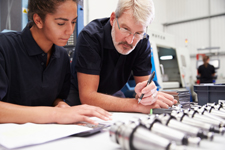
How can student records most accurately reflect student learning?--That’s the question driving a pilot project funded by a grant from the Lumina Foundation. The project is spearheaded by AACRAO and NASPA: Student Affairs Professionals in Higher Education, and is focused on developing comprehensive student records that document evidence of student learning and achievement beyond traditional course names, credits, and grades.
The current project includes eleven higher education institutions* – two- and four-year, public and private – that are already developing competency-based education approaches to education and/or documenting co-curricular experiences.
AACRAO is publishing a series of articles detailing the makeup of each model record, the campus-wide collaboration required to enact change, and the goals each model is designed to achieve. For the first feature, we talk with Rodney Parks, University Registrar at Elon University, an institution that has collected and presented co-curricular data since 1994.
Each of the institutions involved in the pilot project serves a different student population. Elon’s student body is made up of the “traditional, residential campus, 18-22 year-old,” Parks said, “which is actually not the ‘average student’ anymore.”
The roots of change
“Back in 2013, we took that cocurricular transcript previously offered through student affairs and gave it a ‘registrar’ flair, making it look like an academic transcript,” said Parks. “It’s data-driven, and captures a more comprehensive experience than just the academic transcript alone.”
Students must opt-in to receive the cocurricular transcript, which is released as part of a PDF file that includes both the academic and experiential transcript—the first in maroon and the second in gold (Elon’s school colors). The “opt-in” aspect is important because not all students have a robust co-curricular experience, and the absence of that data might be noticeable.
“Everyone loved that new innovation to paint a more comprehensive picture, and we had good feedback from employers who said they wanted more information like this,” Parks said. “That led to our selection as part of the Lumina grant project.”
Creating the prototype
Over the last year, Elon has worked with a third-party vendor to create a prototype of a visual cocurricular transcript that could be both appealing and useful to prospective employers. The original infographic was imagined as a one-page timeline, but that was ultimately deemed unworkable because of the amount of experiences some students accumulate over four years.
“We settled on a two-page document where people see experiences by year,” Parks said. “Our average student has eight cocurricular experiences.” The infographic can be expanded or contracted to suit the individual, so there’s not a noticeable gap in the visual layout.
With the help of their vendor, Parchment, Elon built a user-friendly web platform where student information and experiences can be uploaded as an Excel spreadsheet to create the PDF infographic. Each experience has a code and associated icon. The front page of the visual transcript uses those icons to present a summary of each experience, and the second page presents that data as a visualization. The goal is to make the visual transcript something that is easily digestible for readers as well as sharable via social media.
The grant process required that the platform be replicable at other institutions. This model can be modified so other institutions can establish different categories that better suit their cocurricular values.
“For example, if a school wanted to put ‘student work on campus’ or another experience that they hold culturally important at their institution, they could,” Parks said.
Codifying the cocurricular experience
Elon breaks down cocurricular experiences into five categories—leadership, community service, global education, research, and internships. To graduate, a student must complete at least two experiential learning requirements—so experiential learning is already built into the curriculum at Elon.
“One unique thing about Elon—we are collecting the cocurricular data for the student,” Parks said. “When the burden of capturing that data is on the student, it rarely gets done.” For example, there is a Center for Service Learning, which is responsible for entering and maintaining the integrity of students’ community service data. A committee including Student Affairs, Academic Affairs, and faculty works together to review whether or not something qualifies as a cocurricular experience.
Since securing the grant last summer, Elon University has worked with consultants from AACRAO and NASPA to talk through some of their ideas and challenges.
“The collaboration with AACRAO and NASPA has been critical—as has collaboration across campus,” Parks said. “It really takes a village, as they say—it’s about developing the mindset that this endeavor is strategically important to every person in higher education.”
View an example of Elon's innovative visual transcript by downloading the Powerpoint file below.
For more information, view the Comprehensive Student Record Project website.
* The twelve institutions are as follows:
Borough of Manhattan Community College
Brandman University
Dillard University
Elon University
Indiana University – Purdue University Indianapolis
LaGuardia Community College
Stanford University
University of Central Oklahoma
University of Houston-Downtown
University of Maryland University College
University of South Carolina
University of Wisconsin – Extension and Wisconsin Colleges